The Cambridge History of Japan, Vol. 4: Early Modern Japan
Подождите немного. Документ загружается.


THOUGHT 395
necessary for him to create an ujigami protector of his house, in the
same way that Hachiman, for instance, protected the Genji and the
Ashikaga houses. Moreover, as one who died fearing for the political
future of the Toyotomi house, it was quite natural that Hideyoshi
should wish to become a kami, capable of directly influencing this
world, rather than a hotoke, whose power over this world would be
limited. These various factors contributed to the creation of a new
type of shrine, dedicated to the Toyotomi house. Apart from such
factors particular to Hideyoshi, the general religious consciousness of
the day was already prepared to accept the practice of enshrining a
human being as a kami.
The enshrinement of Tokugawa Ieyasu, who succeeded Hideyoshi
as the nation's dominant political figure, was a further manifestation
of this religious trend. Ieyasu was deified as Tosho Daigongen the year
after his death in 1616, and the Toshogu Shrine at Nikko was built to
enshrine him. Moreover, from the seventeenth century on, not only
political figures but also people of lesser stature came to be regarded as
kami. Daimyo, Shinto teachers, and people who had accomplished
some deeds of particular social merit frequently were enshrined as
kami after their death or even during their lifetime. Connections might
also be drawn between the growth of this religious consciousness that
assumed a close linkage between this world and the world to come,
and certain social phenomena of the seventeenth century. For exam-
ple,there was the practice of self-immolation on the death of one's lord
(a practice known asjunshi), which achieved a certain currency among
bushi in the first part of the century, and the wave of double suicides
(shinju),
which swept commoner society in the latter half of the cen-
tury. Both phenomena rested on the assumption that one could achieve
after death what was unattainable in this world and hence may have
been nourished by the same religious consciousness that sustained the
practice of enshrining humans as kami.
THOUGHT
Ever since humans first became conscious of their own existence, they
have posed the question of how they should live. When efforts to
answer this question focused on the state of the human spirit or of a
soul, which was presumed to survive the death of the individual, it was
primarily a religious question. By contrast, when the issue of how the
individual should behave within actual society was emphasized, it
became mainly a matter of morality or ethics. The question of morality
Cambridge Histories Online © Cambridge University Press, 2008

396 THOUGHT AND RELIGION: I55O-I7OO
was inextricably bound up with the nature of the society or state
within which the individual acted. Consequently, the discussion of
morality extended naturally to the question of
the
kind of government
needed to ensure social and political order. Discussions of morality
also had a significant religious dimension, particularly when address-
ing the question of humanity's basic nature. And in the premodern
world, speculation about the social or political order usually entailed
the premise of some link between that order and a transcendental
authority. Thus, the discussion of politics cannot be separated com-
pletely from religion. Nevertheless, in what follows I shall focus on
thought in the sense of more or less systematic ideas about the prob-
lems of morality and politics, as distinguished from more purely reli-
gious conceptions.
In Japan, from the sixteenth century on, thought in this sense devel-
oped independently of religion. From antiquity, Confucianism, trans-
mitted to Japan from China, had served as the source of ideas about
morality and politics. However, up to the fifteenth century, Confucian-
ism had remained a branch of scholarship of interest almost exclu-
sively confined to Buddhist clergy and intellectuals of the upper, aristo-
cratic, stratum of society; it had virtually no impact on society as a
whole. Rather, the general population turned to religious teachings, in
particular those of Buddhism, for intellectual guidance. Then, during
the fifteenth century, a fundamental reorientation took place in the
nation's religious life that reassured people concerning their fate after
death and shifted their interest toward questions of politics and moral-
ity. The stabilization of people's livelihood and the possibility for
future improvement that accompanied the spread of the house struc-
ture throughout society also encouraged such a shift in emphasis.
The development of thought in a form independent from religion
sometimes is explained as the result of the separation of religion and
thought, or even as the result of
a
trend toward the rejection of religion.
More accurately, however, the
new
interest in the question of
how to
live
in actual society should be seen as a consequence of the permeation of
religion into the lives of the general populace. Confucianism, which
played a central part in this intellectual activity, had a certain religious
dimension, and several prominent Buddhist and Shinto clerics entered
the debate over politics and morality from their own specialized, reli-
gious point of
view.
What distinguished the activities of these figures
from those of both earlier and later periods is that they, like the Confu-
cian thinkers of this era, characteristically took up as individuals rather
than as the leaders of
a
religious movement the question of how
to
live in
Cambridge Histories Online © Cambridge University Press, 2008
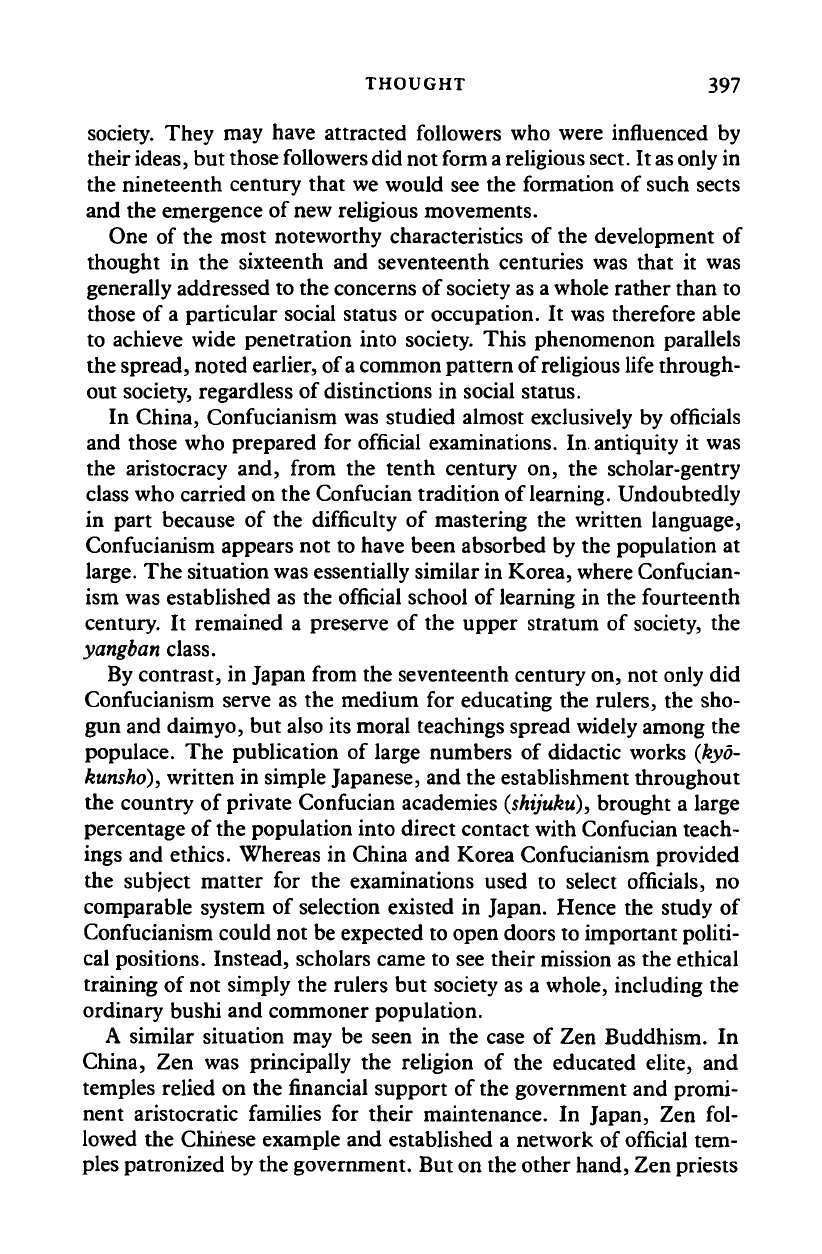
THOUGHT 397
society. They may have attracted followers who were influenced by
their
ideas,
but those followers did not form
a
religious
sect.
It
as
only in
the nineteenth century that we would see the formation of such sects
and the emergence of new religious movements.
One of the most noteworthy characteristics of the development of
thought in the sixteenth and seventeenth centuries was that it was
generally addressed to the concerns of society as
a
whole rather than to
those of a particular social status or occupation. It was therefore able
to achieve wide penetration into society. This phenomenon parallels
the spread, noted earlier, of
a
common pattern of religious life through-
out society, regardless of distinctions in social status.
In China, Confucianism was studied almost exclusively by officials
and those who prepared for official examinations. In antiquity it was
the aristocracy and, from the tenth century on, the scholar-gentry
class who carried on the Confucian tradition of
learning.
Undoubtedly
in part because of the difficulty of mastering the written language,
Confucianism appears not to have been absorbed by the population at
large. The situation was essentially similar in Korea, where Confucian-
ism was established as the official school of learning in the fourteenth
century. It remained a preserve of the upper stratum of society, the
yangban class.
By contrast, in Japan from the seventeenth century on, not only did
Confucianism serve as the medium for educating the rulers, the sho-
gun and daimyo, but also its moral teachings spread widely among the
populace. The publication of large numbers of didactic works (kyo-
kunsho),
written in simple Japanese, and the establishment throughout
the country of private Confucian academies
(shijuku),
brought a large
percentage of the population into direct contact with Confucian teach-
ings and ethics. Whereas in China and Korea Confucianism provided
the subject matter for the examinations used to select officials, no
comparable system of selection existed in Japan. Hence the study of
Confucianism could not be expected to open doors to important politi-
cal positions. Instead, scholars came to see their mission as the ethical
training of not simply the rulers but society as a whole, including the
ordinary bushi and commoner population.
A similar situation may be seen in the case of Zen Buddhism. In
China, Zen was principally the religion of the educated elite, and
temples relied on the financial support of the government and promi-
nent aristocratic families for their maintenance. In Japan, Zen fol-
lowed the Chinese example and established a network of official tem-
ples patronized by the government. But on the other hand, Zen priests
Cambridge Histories Online © Cambridge University Press, 2008
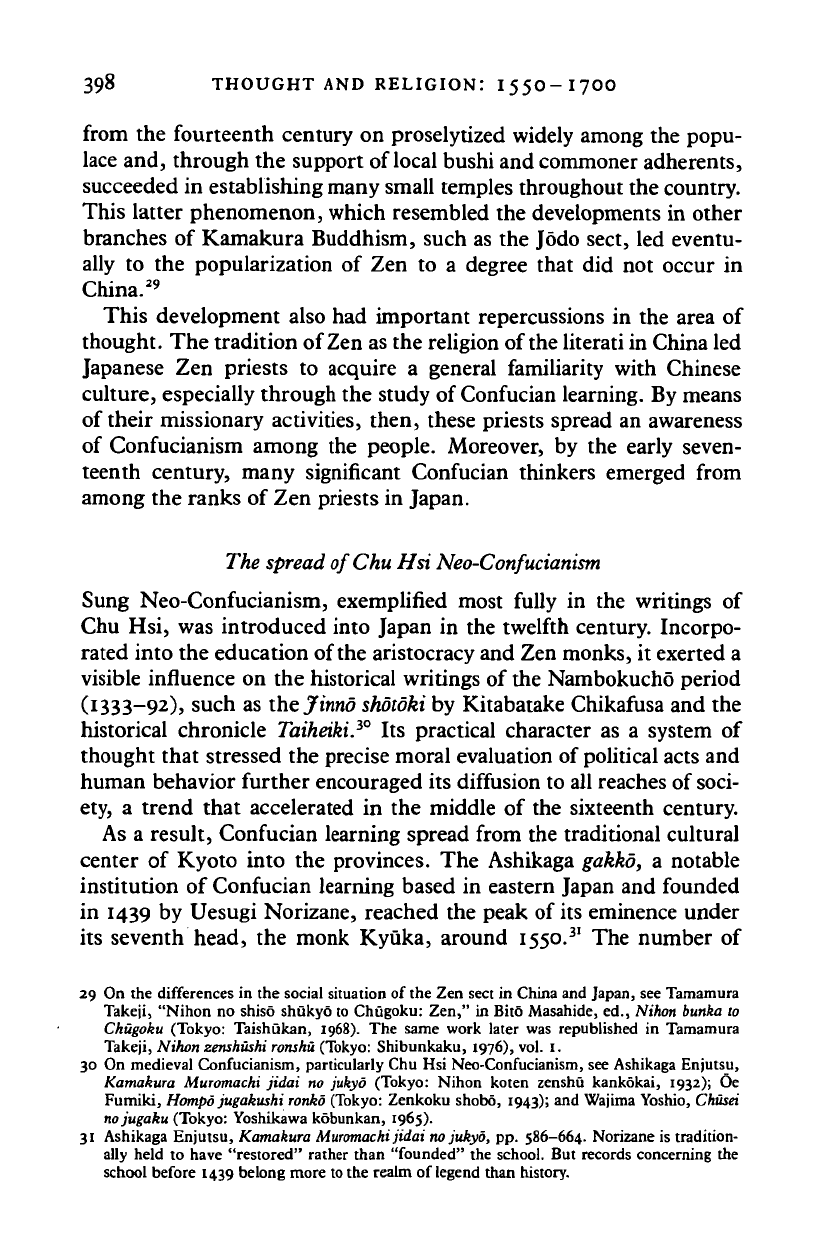
398 THOUGHT AND RELIGION: I55O-
from the fourteenth century on proselytized widely among the popu-
lace and, through the support of
local
bushi and commoner adherents,
succeeded in establishing many small temples throughout the country.
This latter phenomenon, which resembled the developments in other
branches of Kamakura Buddhism, such as the Jodo sect, led eventu-
ally to the popularization of Zen to a degree that did not occur in
China.
29
This development also had important repercussions in the area of
thought. The tradition of Zen as the religion of the literati in China led
Japanese Zen priests to acquire a general familiarity with Chinese
culture, especially through the study of Confucian learning. By means
of their missionary activities, then, these priests spread an awareness
of Confucianism among the people. Moreover, by the early seven-
teenth century, many significant Confucian thinkers emerged from
among the ranks of Zen priests in Japan.
The spread ofChu Hsi Neo-Confucianism
Sung Neo-Confucianism, exemplified most fully in the writings of
Chu Hsi, was introduced into Japan in the twelfth century. Incorpo-
rated into the education of the aristocracy and Zen monks, it exerted a
visible influence on the historical writings of the Nambokucho period
C
1
333-9
2
)5 such as the Jinno
shotoki
by Kitabatake Chikafusa and the
historical chronicle Taiheiki.
30
Its practical character as a system of
thought that stressed the precise moral evaluation of political acts and
human behavior further encouraged its diffusion to all reaches of soci-
ety, a trend that accelerated in the middle of the sixteenth century.
As a result, Confucian learning spread from the traditional cultural
center of Kyoto into the provinces. The Ashikaga gakko, a notable
institution of Confucian learning based in eastern Japan and founded
in 1439 by Uesugi Norizane, reached the peak of its eminence under
its seventh head, the monk Kyuka, around 1550.
3I
The number of
29 On the differences in the social situation of the Zen sect in China and Japan, see Tamamura
Takeji, "Nihon no shiso shukyo to Chugoku: Zen," in Bito Masahide, ed., Nihon bunka to
Chugoku (Tokyo: Taishukan, 1968). The same work later was republished in Tamamura
Takeji, Nihon
zenshushi ronshu
(Tokyo: Shibunkaku, 1976), vol. 1.
30 On medieval Confucianism, particularly Chu Hsi Neo-Confucianism, see Ashikaga Enjutsu,
Kamakura Muromachi jidai no jukyo (Tokyo: Nihon koten zenshu kankokai, 1932); Oe
Fumiki, Hompo jugakushi ronko (Tokyo: Zenkoku shobo, 1943); and Wajima Yoshio, Chiisei
nojugaku (Tokyo: Yoshikawa kobunkan, 1965).
31 Ashikaga Enjutsu, Kamakura Muromachi jidai
no
jukyo, pp. 586-664. Norizane is tradition-
ally held to have "restored" rather than "founded" the school. But records concerning the
school before 1439 belong more to the realm of legend than history.
Cambridge Histories Online © Cambridge University Press, 2008

THOUGHT 399
students who gathered at the school during this period is said to have
numbered three thousand. From about 1560 the school was supported
by the Go-Hojo, the Sengoku daimyo who at that time controlled most
of the Kanto region. This circumstance further enhanced the school's
stature. Most of the students were Zen priests, but their studies cen-
tered on Confucianism, if not pure Chu Hsi thought. Particular empha-
sis was given to the study of the Book of
Changes,
a text of central
importance to the practice of divination, and thus of interest to the
daimyo, who were constantly confronted with the uncertainties of
warfare. However, the interests of daimyo like the Go-Hojo were not
limited to divination but also encompassed Confucian teachings about
morality and government.
For example, the
Hojo
godaiki,
which records the history of the Go-
Hojo house, describes the successive heads of
the
family and the major
Go-Hojo vassals as having emphasized the importance of Confucian
moral values. A similar interest may be observed in the case of another
major eastern daimyo, the Takeda of Kai. Apart from the fifty-seven-
article legal code compiled under the direction of the famous general
Takeda Shingen, there also exists a set of ninety-nine admonitions
compiled in 1558 by Shingen's younger brother Nobushige, which
cites references from Confucian texts such as the
Analects.
Other Sengoku daimyo exhibited an interest in Confucianism as
well. Known particularly for their influence on the intellectual world
were the schools of Confucianism that developed under the sponsor-
ship of the daimyo of Tosa and Satsuma. The Tosa school (the so-
called Southern school) of Confucianism got its start under the Zen
priest Nanson Baiken, who came to Tosa around 1548 or 1549. The
Satsuma ("Satsunan") school claimed the fifteenth-century Zen priest
Keian Genju (1429-1508) as its founder but began to flourish only
under
a
later Zen priest, Nampo Bunshi (1556-1620). These priests all
studied Confucianism at the Gozan temples in Kyoto, which stressed
Chu Hsi's interpretations of Confucianism.
In both Tosa and Satsuma, Confucianism received the patronage of
the daimyo and exerted an influence on the retainers of the house. In
Satsuma, Shimazu Tadayoshi (1492-1568), the father of the domain
lord Shimazu Takahisa, showed a deep interest in learning and com-
posed the "Iroha uta," a set of forty-seven poems (waka) that con-
veyed Confucian moral principles in an easily comprehensible manner.
The first poem states: "Merely to hear or study the way of antiquity is
insufficient; merit derives from one's own practice of the way." Other
poems propagated Confucian ethics together with faith in Buddhism
Cambridge Histories Online © Cambridge University Press, 2008
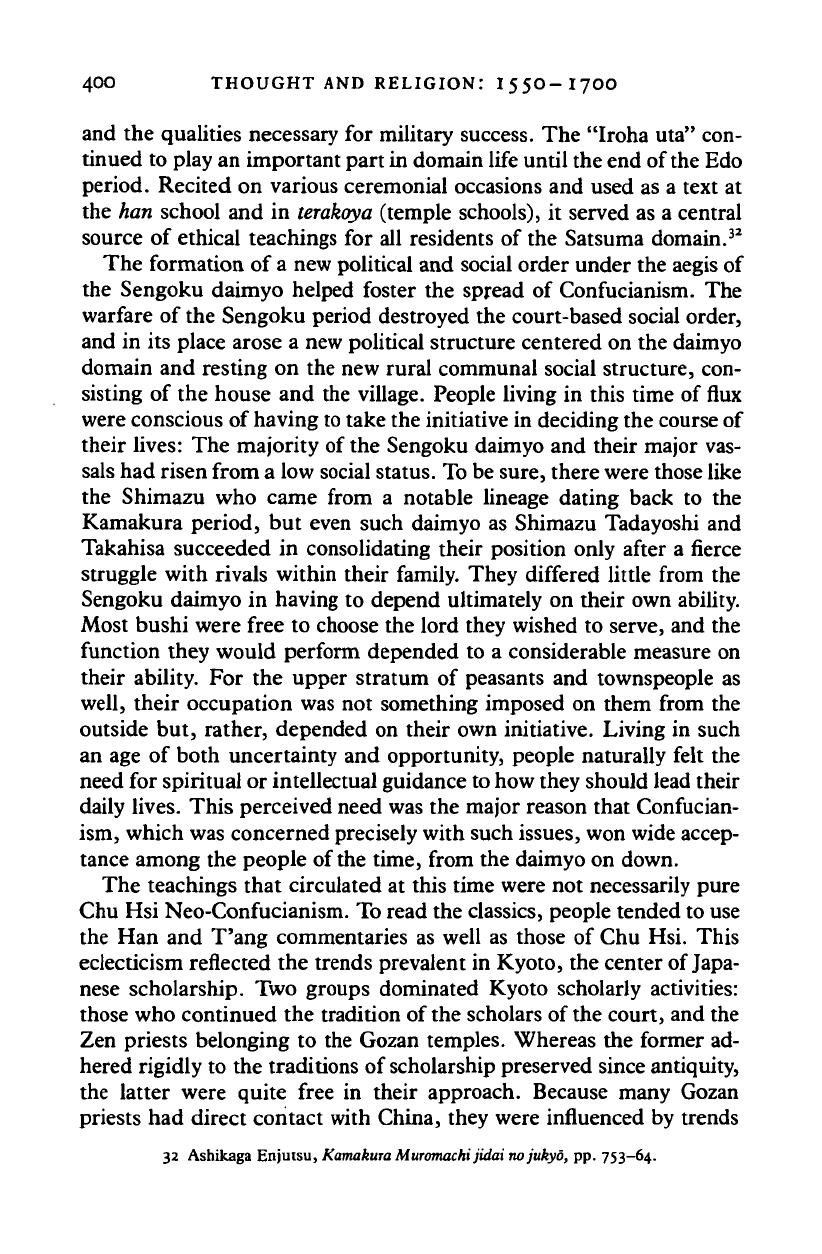
40O THOUGHT AND RELIGION: I55O-I7OO
and the qualities necessary for military success. The "Iroha uta" con-
tinued to play an important part in domain life until the end of the Edo
period. Recited on various ceremonial occasions and used as a text at
the han school and in
terakoya
(temple schools), it served as a central
source of ethical teachings for all residents of the Satsuma domain.
32
The formation of
a
new political and social order under the aegis of
the Sengoku daimyo helped foster the spread of Confucianism. The
warfare of the Sengoku period destroyed the court-based social order,
and in its place arose a new political structure centered on the daimyo
domain and resting on the new rural communal social structure, con-
sisting of the house and the village. People living in this time of flux
were conscious of having to take the initiative in deciding the course of
their lives: The majority of the Sengoku daimyo and their major vas-
sals had risen from a low social status. To be sure, there were those like
the Shimazu who came from a notable lineage dating back to the
Kamakura period, but even such daimyo as Shimazu Tadayoshi and
Takahisa succeeded in consolidating their position only after a fierce
struggle with rivals within their family. They differed little from the
Sengoku daimyo in having to depend ultimately on their own ability.
Most bushi were free to choose the lord they wished to serve, and the
function they would perform depended to a considerable measure on
their ability. For the upper stratum of peasants and townspeople as
well, their occupation was not something imposed on them from the
outside but, rather, depended on their own initiative. Living in such
an age of both uncertainty and opportunity, people naturally felt the
need for spiritual or intellectual guidance to how they should lead their
daily lives. This perceived need was the major reason that Confucian-
ism, which was concerned precisely with such issues, won wide accep-
tance among the people of
the
time, from the daimyo on down.
The teachings that circulated at this time were not necessarily pure
Chu Hsi Neo-Confucianism. To read the classics, people tended to use
the Han and T'ang commentaries as well as those of Chu Hsi. This
eclecticism reflected the trends prevalent in Kyoto, the center of Japa-
nese scholarship. Two groups dominated Kyoto scholarly activities:
those who continued the tradition of the scholars of the court, and the
Zen priests belonging to the Gozan temples. Whereas the former ad-
hered rigidly to the traditions of scholarship preserved since antiquity,
the latter were quite free in their approach. Because many Gozan
priests had direct contact with China, they were influenced by trends
32 Ashikaga Enjutsu, Kamakura Muromachi jidai nojukyo, pp. 753-64.
Cambridge Histories Online © Cambridge University Press, 2008
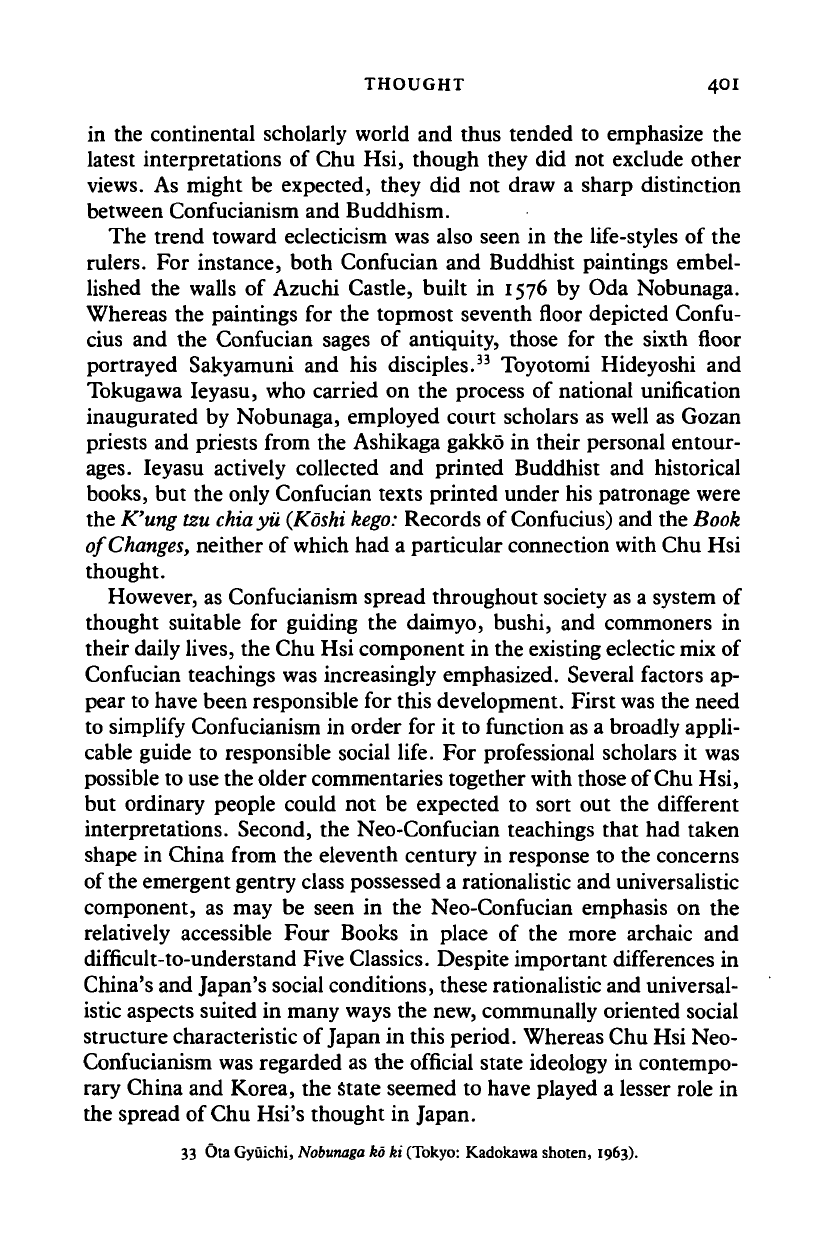
THOUGHT 401
in the continental scholarly world and thus tended to emphasize the
latest interpretations of Chu Hsi, though they did not exclude other
views.
As might be expected, they did not draw a sharp distinction
between Confucianism and Buddhism.
The trend toward eclecticism was also seen in the life-styles of the
rulers.
For instance, both Confucian and Buddhist paintings embel-
lished the walls of Azuchi Castle, built in 1576 by Oda Nobunaga.
Whereas the paintings for the topmost seventh floor depicted Confu-
cius and the Confucian sages of antiquity, those for the sixth floor
portrayed Sakyamuni and his disciples.
33
Toyotomi Hideyoshi and
Tokugawa Ieyasu, who carried on the process of national unification
inaugurated by Nobunaga, employed court scholars as well as Gozan
priests and priests from the Ashikaga gakko in their personal entour-
ages.
Ieyasu actively collected and printed Buddhist and historical
books, but the only Confucian texts printed under his patronage were
the K'ung tzu chiayii
(Koshi
kego:
Records of Confucius) and the
Book
of
Changes,
neither of which had a particular connection with Chu Hsi
thought.
However, as Confucianism spread throughout society as a system of
thought suitable for guiding the daimyo, bushi, and commoners in
their daily lives, the Chu Hsi component in the existing eclectic mix of
Confucian teachings was increasingly emphasized. Several factors ap-
pear to have been responsible for this development. First was the need
to simplify Confucianism in order for it to function as a broadly appli-
cable guide to responsible social life. For professional scholars it was
possible to use the older commentaries together with those of Chu Hsi,
but ordinary people could not be expected to sort out the different
interpretations. Second, the Neo-Confucian teachings that had taken
shape in China from the eleventh century in response to the concerns
of the emergent gentry class possessed a rationalistic and universalistic
component, as may be seen in the Neo-Confucian emphasis on the
relatively accessible Four Books in place of the more archaic and
difficult-to-understand Five Classics. Despite important differences in
China's and Japan's social conditions, these rationalistic and universal-
istic aspects suited in many ways the new, communally oriented social
structure characteristic of Japan in this period. Whereas Chu Hsi Neo-
Confucianism was regarded as the official state ideology in contempo-
rary China and Korea, the state seemed to have played a lesser role in
the spread of Chu Hsi's thought in Japan.
33 Ota Gyuichi, Nobunaga ko ki (Tokyo: Kadokawa shoten, 1963).
Cambridge Histories Online © Cambridge University Press, 2008
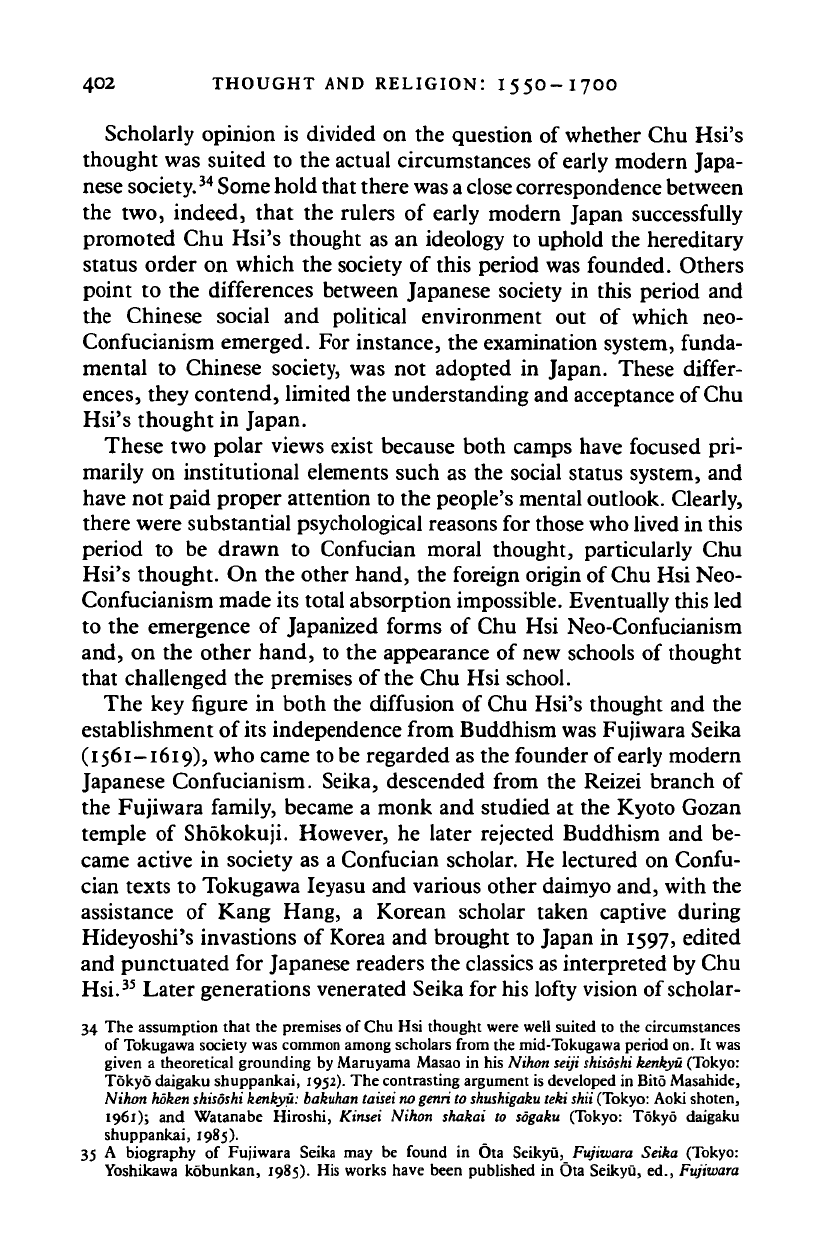
402 THOUGHT AND RELIGION: I55O-I7OO
Scholarly opinion is divided on the question of whether Chu Hsi's
thought was suited to the actual circumstances of early modern Japa-
nese society.
34
Some hold that there
was a close
correspondence between
the two, indeed, that the rulers of early modern Japan successfully
promoted Chu Hsi's thought as an ideology to uphold the hereditary
status order on which the society of this period was founded. Others
point to the differences between Japanese society in this period and
the Chinese social and political environment out of which neo-
Confucianism emerged. For instance, the examination system, funda-
mental to Chinese society, was not adopted in Japan. These differ-
ences,
they contend, limited the understanding and acceptance of Chu
Hsi's thought in Japan.
These two polar views exist because both camps have focused pri-
marily on institutional elements such as the social status system, and
have not paid proper attention to the people's mental outlook. Clearly,
there were substantial psychological reasons for those who lived in this
period to be drawn to Confucian moral thought, particularly Chu
Hsi's thought. On the other hand, the foreign origin of Chu Hsi Neo-
Confucianism made its total absorption impossible. Eventually this led
to the emergence of Japanized forms of Chu Hsi Neo-Confucianism
and, on the other hand, to the appearance of new schools of thought
that challenged the premises of the Chu Hsi school.
The key figure in both the diffusion of Chu Hsi's thought and the
establishment of
its
independence from Buddhism was Fujiwara Seika
(1561-1619), who came to be regarded as the founder of early modern
Japanese Confucianism. Seika, descended from the Reizei branch of
the Fujiwara family, became a monk and studied at the Kyoto Gozan
temple of Shokokuji. However, he later rejected Buddhism and be-
came active in society as a Confucian scholar. He lectured on Confu-
cian texts to Tokugawa Ieyasu and various other daimyo and, with the
assistance of Kang Hang, a Korean scholar taken captive during
Hideyoshi's invastions of Korea and brought to Japan in 1597, edited
and punctuated for Japanese readers the classics as interpreted by Chu
Hsi.
35
Later generations venerated Seika for his lofty vision of scholar-
34 The assumption that the premises of Chu Hsi thought were well suited to the circumstances
of Tokugawa society was common among scholars from the mid-Tokugawa period on. It was
given a theoretical grounding by Maruyama Masao in his Nihon seiji
shisoshi kenkyu
(Tokyo:
Tokyo daigaku shuppankai, 1952). The contrasting argument is developed in Bito Masahide,
Nihon
hdken shisoshi
kenkyu:
bakuhan
taisei
no genri
to
shushigaku
teki
shii
(Tokyo:
Aoki shoten,
1961);
and Watanabe Hiroshi, Kinsei Nihon shaken to sogaku (Tokyo: Tokyo daigaku
shuppankai, 1985).
35 A biography of Fujiwara Seika may be found in Ota Seikyu, Fujiwara Seika (Tokyo:
Yoshikawa kobunkan, 1985). His works have been published in Ota Seikyu, ed., Fujiwara
Cambridge Histories Online © Cambridge University Press, 2008
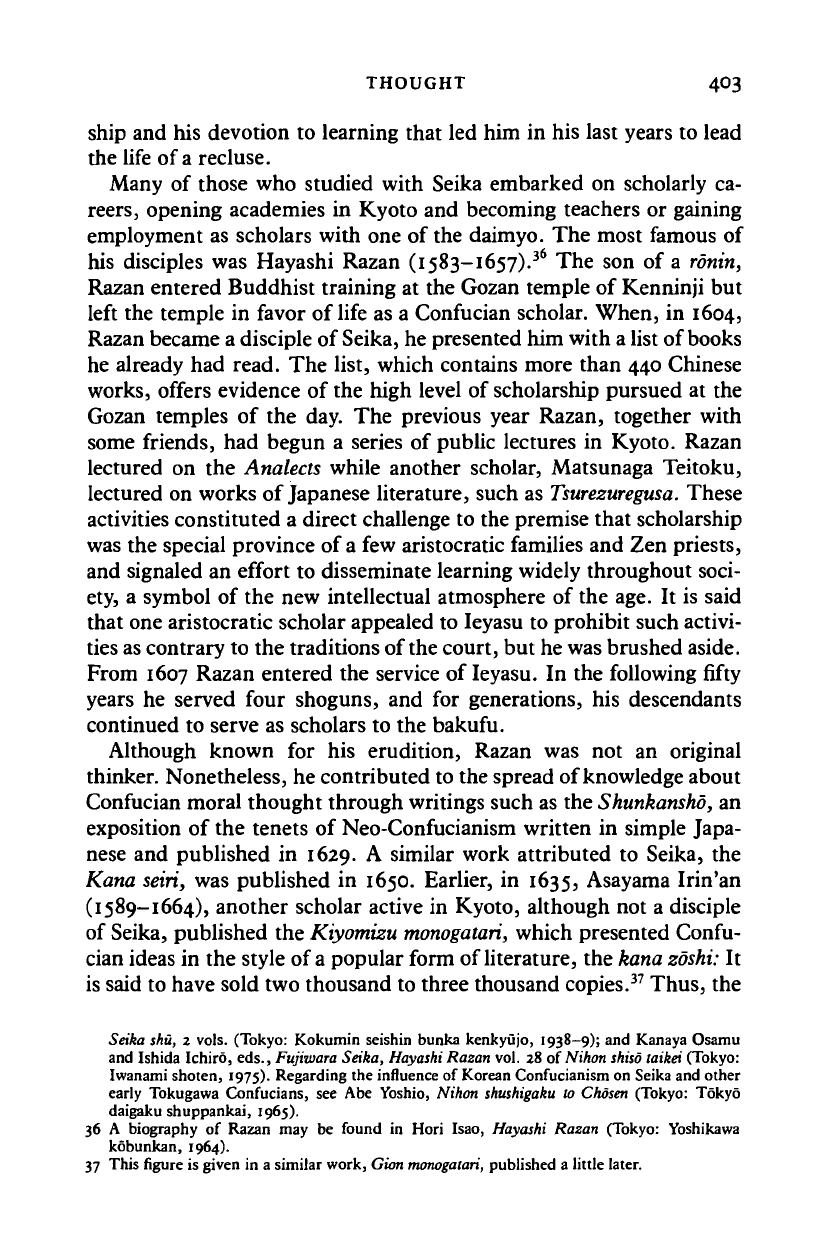
THOUGHT 403
ship and his devotion to learning that led him in his last years to lead
the life of
a
recluse.
Many of those who studied with Seika embarked on scholarly ca-
reers,
opening academies in Kyoto and becoming teachers or gaining
employment as scholars with one of the daimyo. The most famous of
his disciples was Hayashi Razan (1583-1657).
35
The son of a ronin,
Razan entered Buddhist training at the Gozan temple of Kenninji but
left the temple in favor of life as a Confucian scholar. When, in 1604,
Razan became
a
disciple of
Seika,
he presented him with
a
list of books
he already had read. The list, which contains more than 440 Chinese
works, offers evidence of the high level of scholarship pursued at the
Gozan temples of the day. The previous year Razan, together with
some friends, had begun a series of public lectures in Kyoto. Razan
lectured on the Analects while another scholar, Matsunaga Teitoku,
lectured on works of Japanese literature, such as
Tsurezuregusa.
These
activities constituted a direct challenge to the premise that scholarship
was the special province of
a
few aristocratic families and Zen priests,
and signaled an effort to disseminate learning widely throughout soci-
ety, a symbol of the new intellectual atmosphere of the age. It is said
that one aristocratic scholar appealed to Ieyasu to prohibit such activi-
ties as contrary to the traditions of
the
court, but he was brushed aside.
From 1607 Razan entered the service of Ieyasu. In the following fifty
years he served four shoguns, and for generations, his descendants
continued to serve as scholars to the bakufu.
Although known for his erudition, Razan was not an original
thinker. Nonetheless, he contributed to the spread of knowledge about
Confucian moral thought through writings such as the
Shunkansho,
an
exposition of the tenets of Neo-Confucianism written in simple Japa-
nese and published in 1629. A similar work attributed to Seika, the
Kana
seiri,
was published in 1650. Earlier, in 1635, Asayama Irin'an
(1589-1664), another scholar active in Kyoto, although not a disciple
of Seika, published the
Kiyomizu
monogatari,
which presented Confu-
cian ideas in the style of
a
popular form of
literature,
the
kana
zoshi:
It
is said to have sold two thousand to three thousand copies.
37
Thus, the
Seika shu, 2 vols. (Tokyo: Kokumin seishin bunka kenkyujo, 1938-9); and Kanaya Osamu
and Ishida Ichiro, eds., Fujiwara Seika, Hayashi Razan vol. 28 of Nihon
shiso
taikei (Tokyo:
Iwanami shoten, 1975). Regarding the influence of Korean Confucianism on Seika and other
early Tokugawa Confucians, see Abe Yoshio, Nihon
shushigaku
to Chosen (Tokyo: Tokyo
daigaku shuppankai, 1965).
36 A biography of Razan may be found in Hori Isao, Hayashi Razan (Tokyo: Yoshikawa
kobunkan, 1964).
37 This figure is given in a similar work, Gum
monogatari,
published a little later.
Cambridge Histories Online © Cambridge University Press, 2008
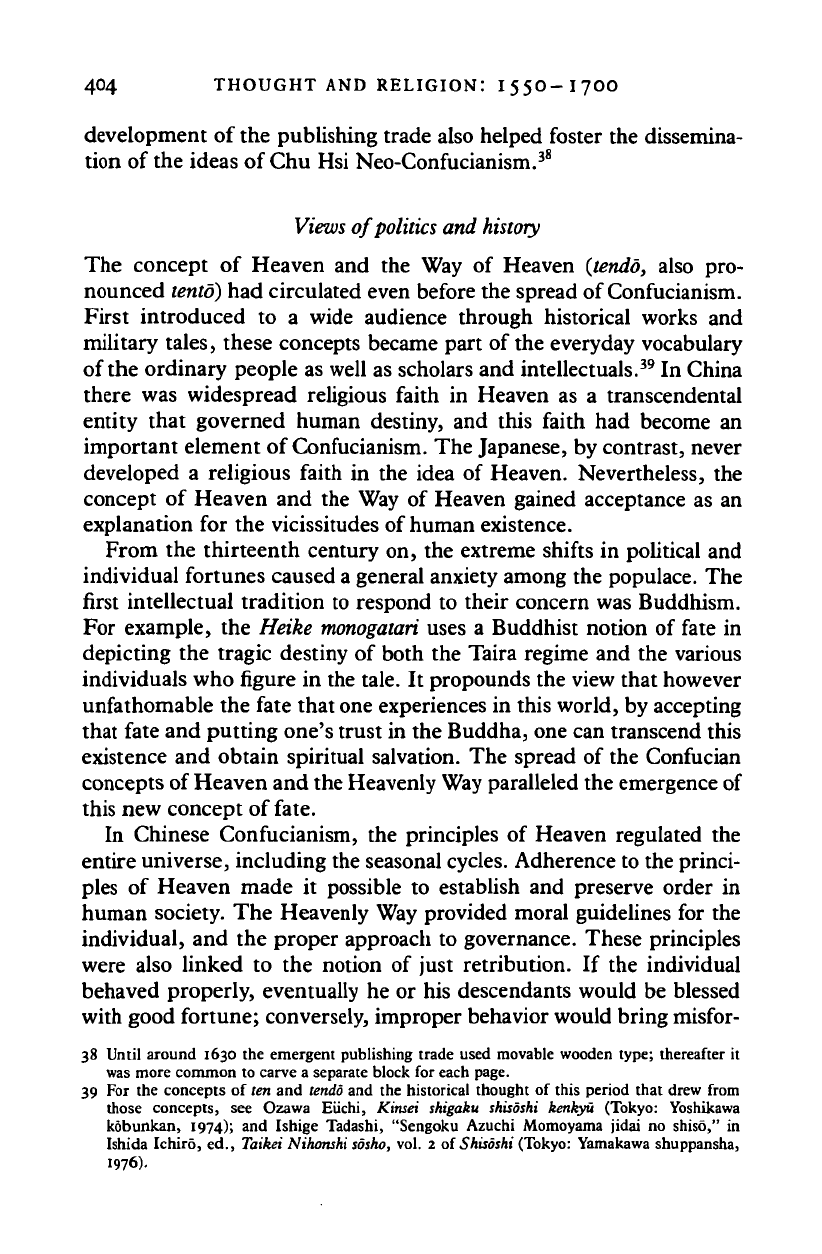
404 THOUGHT AND RELIGION: 1550-1700
development of the publishing trade also helped foster the dissemina-
tion of the ideas of Chu Hsi Neo-Confucianism.
38
Views of politics and history
The concept of Heaven and the Way of Heaven (tendo, also pro-
nounced
lento)
had circulated even before the spread of Confucianism.
First introduced to a wide audience through historical works and
military tales, these concepts became part of the everyday vocabulary
of the ordinary people as well as scholars and intellectuals.
39
In China
there was widespread religious faith in Heaven as a transcendental
entity that governed human destiny, and this faith had become an
important element of Confucianism. The Japanese, by contrast, never
developed a religious faith in the idea of Heaven. Nevertheless, the
concept of Heaven and the Way of Heaven gained acceptance as an
explanation for the vicissitudes of human existence.
From the thirteenth century on, the extreme shifts in political and
individual fortunes caused a general anxiety among the populace. The
first intellectual tradition to respond to their concern was Buddhism.
For example, the Heike
monogatari
uses a Buddhist notion of fate in
depicting the tragic destiny of both the Taira regime and the various
individuals who figure in the tale. It propounds the view that however
unfathomable the fate that one experiences in this world, by accepting
that fate and putting one's trust in the Buddha, one can transcend this
existence and obtain spiritual salvation. The spread of the Confucian
concepts of Heaven and the Heavenly Way paralleled the emergence
of
this new concept of fate.
In Chinese Confucianism, the principles of Heaven regulated the
entire universe, including the seasonal
cycles.
Adherence to the princi-
ples of Heaven made it possible to establish and preserve order in
human society. The Heavenly Way provided moral guidelines for the
individual, and the proper approach to governance. These principles
were also linked to the notion of just retribution. If the individual
behaved properly, eventually he or his descendants would be blessed
with good fortune; conversely, improper behavior would bring misfor-
38 Until around 1630 the emergent publishing trade used movable wooden type; thereafter it
was more common to carve a separate block for each page.
39 For the concepts of ten and tendo and the historical thought of this period that drew from
those concepts, see Ozawa Eiichi, Kinsei shigaku shisoshi kenkyu (Tokyo: Yoshikawa
kobunkan, 1974); and Ishige Tadashi, "Sengoku Azuchi Momoyama jidai no shiso," in
Ishida Ichiro, ed., Taikei Nihonshi
sosho,
vol. 2 of
Shisoshi
(Tokyo: Yamakawa shuppansha,
1976).
Cambridge Histories Online © Cambridge University Press, 2008
